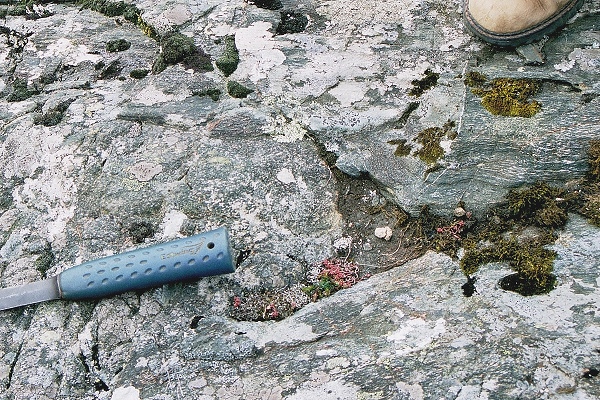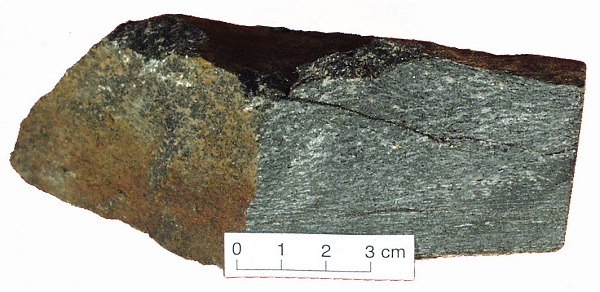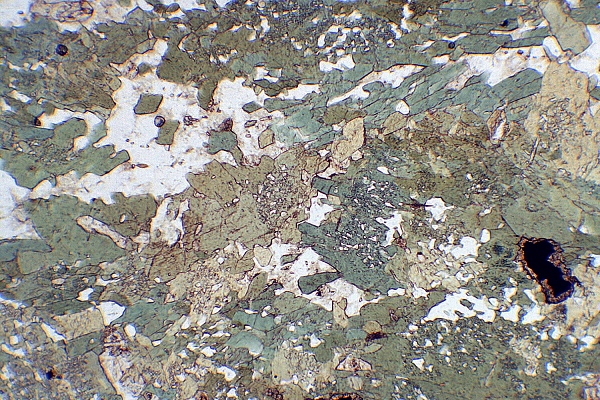
| Home | Geological History | Stratigraphy | Area map | Rock Index | About |
| Scourie | Achmelvich | Laxford | Clachtoll | Stoer | Assynt | Skiag Bridge | Glencoul | Knockan | Borralan | Ledmore |
This sample is from about 1 km north of Achmelvich, in a shear zone formed during the Laxfordian episode

![]() Amphibolite, Lewisian Gneiss Complex, Achmelvich
Amphibolite, Lewisian Gneiss Complex, Achmelvich
This outcrop lies inland, away from the clean outcrops on
the shore and from fresh roadside cuts. It illustrates one
of the geologist's common problems: the outcrop surface is
partly covered by lichens and moss, and the true rock
surface is rather difficult to distinguish. A geologist has
to learn to look past the encrusting material and not be
distracted by it! If you are sharp-eyed, and look at the
areas below the geologist's boot and above the hammer
handle, you can make out that the rock consists of dark
green and white minerals with a speckled texture. You may
also detect that the banding and mineral alignment are
stronger at the right of the picture than they are at the
centre. This is an amphibolite, consisting of hornblende
and plagioclase feldspar.

![]() Amphibolite, Lewisian Gneiss Complex, Achmelvich
Amphibolite, Lewisian Gneiss Complex, Achmelvich
This rock is from one of the Scourie dykes. Because it now
has a metamorphic texture, with minerals aligned in a
banding, we know that these minerals formed later than the
time of dyke intrusion (2000 million years). Therefore, the
metamorphism we see here happened in the Laxfordian episode
(1800 to 1750 million years) rather than the earlier
Scourian episode. The rock consists almost entirely of two
minerals, very dark green hornblende and white feldspar.
Such rocks are called amphibolites, and they are
medium-grade metamorphic rocks formed usually from basic
igneous rocks like basalt and gabbro. Notice how the grain
size is finer and the banding is more intense in the lower
half of the specimen, whereas in the upper half the white
feldspar specks are less flattened. Rocks are seldom
deformed evenly, and this one has been sheared more
intensely along certain zones.

![]() Amphibolite, Lewisian Gneiss Complex,
Achmelvich
Amphibolite, Lewisian Gneiss Complex,
Achmelvich
This amphibolite formed by metamorphism of a gabbro (in
one of the Scourie dykes). The part of the rock that is
less strongly sheared has rather broad, spongy-looking
blue-green hornblende crystals and irregular patches of
feldspar. It is obviously a metamorphic rock, but it has
only a weak banding, and the distribution of dark and light
minerals is not unlike that of the pyroxene and feldspar in
the original gabbro.
Plane polarized light, field of view 3 mm across

![]() Amphibolite, Lewisian Gneiss Complex,
Achmelvich
Amphibolite, Lewisian Gneiss Complex,
Achmelvich
Other parts of the amphibolite sample, only centimetres
away, have been dramatically changed by shearing and
recrystallization. Here the grain size is much finer. The
amphibole crystals are strongly aligned and arranged in a
banding of dark and light minerals.
Plane polarized light, field of view 3 mm across
| Scourie | Achmelvich | Laxford | Clachtoll | Stoer | Assynt | Skiag Bridge | Glencoul | Knockan | Borralan | Ledmore |
| Home | Geological History | Stratigraphy | Area map | Rock Index | About |
D.J. Waters, Department of Earth Sciences, May 2003